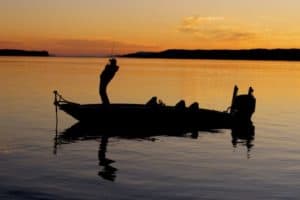By David Hart
If the pre-spawn season is a time of plenty, that period following the spawn can be time of want. Bass that were shallow, hungry and aggressive are nowhere to be found. They’ve disappeared, or it seems that way, and just about every bait that worked a few weeks ago draws nothing but the occasional dink.

Jason Christie will catch post-spawn bass close to the banks in some cases. A few bass always stay shallow, he says, and bass in river systems tend to stay close to shore, as well.
Post-spawn bass, says Oklahoma professional angler Jason Christie, will still hit a lure. They just aren’t where you think they are.
“We used to think they stayed close to the bank and just wouldn’t eat, so we assumed the post-spawn period was just a difficult time to catch bass, but we now know that’s not the case,” says Christie, a two-time Bassmaster Classic qualifier. “A lot of tournaments during the post-spawn are won with some heavy limits. A lot of bass are caught during those tournaments, too.”
Go Deep
Instead of casting a lure to the same shallow water where pre-spawn and spawning bass were so abundant a few weeks ago, back out and fish deeper. But don’t just randomly cast to deeper water. Christie targets ledges, points and other structure in anywhere from 6 to 30 feet of water. That depth depends largely on the reservoir. Post-spawn bass go deeper in clear water, and they’ll stay in as little as 6 feet of water in stained or muddy reservoirs.
Often, finding post-spawn bass in deeper water is nothing more than a matter of searching for them with quality electronics. Christie uses a Garmin 7612 side-view that allows him to probe under his boat as he idles over points, creek channels and other likely spots.

Post-spawn bass often retreat to deeper water, where they hug the bottom on points, ledges and other structure.
“I won’t start fishing until I see something I like,” he says. “I prefer to actually see fish on my depthfinder. They will school up right after the spawn, but a school can be anywhere from three or four bass on some lakes or 25 or even 50 bass on others.”
Best Baits? Just About Anything
Finding bass is the hard part. Catching them? Just about any lure pulled past their noses will draw a strike. Post-spawn bass are not unlike post-rut bucks. They are actively feeding in an effort to rebuild strength and put on much-needed mass lost during the spawning season.
Christies’ favorite post-spawn lures include swim baits like a Yum Money Minnow on a jig head or a Bomber deep-diving crankbait. Faster baits allow him to cover more water, and they tend to draw reaction strikes from both active largemouths and the most lethargic post-spawn bass.

Lures that get close to the bottom will coax post-spawn bass into biting. Deep-diving crankbaits, swimbaits and jigs are all great choices.
The key, he adds, is to get the bait close to the bottom. Post-spawn largemouths tend to stay close to the bottom for several weeks after the spawn. After that, they will suspend under schools of bait and follow those schools around the lake all summer. Some will gravitate towards deeper brushpiles. Others move to shallower grass and other cover, where they spend the rest of the summer.
Exceptions To The Rule
The post-spawn period can last several weeks, but the good news is that not all bass spawn at the same time. Some are well past the difficult phase and have settled into a solid and predictable summer pattern. They’ll hang around brushpiles on points and other structure. Find these bass, and you’ll have consistent fishing virtually all summer. Other bass may still even be guarding a bed this late in the season.
“There are always a few up on the banks pretty much all year,” says Christie. “That’s especially true in river systems, where the constant current keeps bass from going very far off the banks. They’ll stay in grass or around other cover in shallow water.”
In other words, finding post-spawn bass depends largely on the lake or river. Finding them can be the hard part, but when you do, they can be easy to catch.
The Union Sportsmen’s Alliance website is designed to provide valuable articles about hunting, fishing and conservation for members of AFL-CIO affiliated labor unions and all sportsmen and sportswomen who appreciate hunting and fishing and want to preserve our outdoor heritage for future generations. If you would like your own story and experience from the outdoors to be considered for our website, please email us at [email protected].








